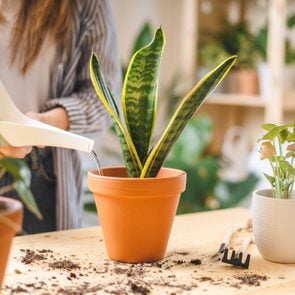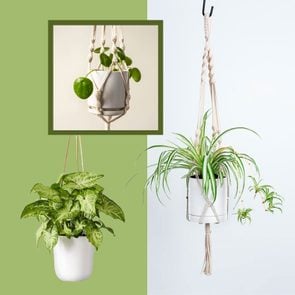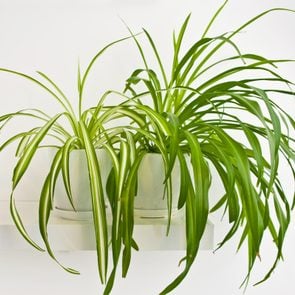How to Care for a ZZ Plant
Updated: Mar. 15, 2024

ZZ plant care couldn't be easier, making this beauty a great option for newbie gardeners
Our editors and experts handpick every product we feature. We may earn a commission from your purchases.Learn more.
Tall, dark and handsome, the ZZ plant has become one of the most fashionable indoor plants around. Perhaps that’s because it’s a stunner, displaying 3- to 5-inch-long leaves—glossy and finger-shaped—on erect branches that grow two to three feet high. Or perhaps it’s because ZZ plant care is so simple that beginner gardeners can tackle it without worrying they’ll end up with a dead plant.
“This is an architectural plant that makes a statement. And it’s so easy,” says Lisa Eldred Steinkopf, author of Houseplants: The Complete Guide to Choosing, Growing and Caring for Indoor Plants. Whether you buy your plant online or from a brick-and-mortar store, you’ll have no problem mastering ZZ plant care. Native to East Africa, these tall indoor plants contain potato-shaped rhizomes (bloated roots) that store water and make them drought-tolerant. In addition, these low-maintenance indoor plants don’t demand much light.
| Botanical name | Zamioculcas zamiifolia |
| Height | 2 to 3 feet |
| Sun exposure | Low to bright indirect light |
| Soil type | Well-draining potting mix |
| Soil pH | Neutral or slightly acidic (6 to 7) |
| Toxicity | Toxic to cats and dogs |
Where to put a ZZ plant
ZZ plants thrive in low to bright indirect light, the sort you’d find in an east-, west- or north-facing window. They cannot tolerate a complete lack of natural light but do well in a windowless room when grown under bright fluorescent lights.
Too much sun is also a no-no. “If they are placed in full, direct sunlight, as in a south-facing window, they may become sunburned,” says Steinkopf.
Ideal temperatures range from 65 to 75 degrees. Since these low-light indoor plants are native to humid climates, they need moisture in the air to thrive. Avoid placing them near heating units or air conditioners that will dry out the air. Brown tips on the leaves may mean that your atmosphere is too arid (misting the leaves may help).
Wherever you place a ZZ plant, the shiny leaves are likely to attract dust. Occasionally wipe them off with a damp cloth to keep them dust free, not just for looks but to also help them function as air-purifying plants that will help detoxify your home.
Finally, because this plant is toxic to cats and dogs, it’s best to display it in a spot where your furry friend won’t take a bite.
ZZ plant care
Knowing where to place your ZZ plant so it’s at the ideal temperature and gets the right indoor plant lighting is a good start. But there are other aspects of ZZ plant care that you’ll need to take into account, including soil, water and fertilization needs.
Whether you’re tending to your own greenery or caring for a family member’s plants, here’s what to do to make sure they have a long life.
Soil
Drainage is the name of the game when it comes to soil type. “ZZ plants need a really well-drained soil,” says Steinkopf.
Make sure your ZZ plant soil contains perlite, small white balls that create air spaces and improve drainage. The soil should be neutral or slightly acidic (a pH of 6 or 7), which is the range most potting soil mixes come in.
These plants are slow to grow, so it’ll be years before you need to learn how to repot a plant.
Water
ZZ plant care requires a light touch with the watering can. Because ZZ rhizomes hold on to water, overwatering can kill your plant. As part of a smart watering plan, wait until the soil is dry on the top three or more inches before you give the plant a drink. This usually works out to about every two weeks.
Beyond that, make sure you empty out the saucer under the container—ZZ plants don’t like sitting in water and could develop root rot. And stop watering it in the winter unless the plant is continuing to grow. “Err on the side of underwatering rather than overwatering,” Steinkopf advises.
So how can you tell if you’re giving your ZZ plant enough to drink? If its leaves are yellow, you may be overwatering. If the leaves are falling off, though, you’re probably underwatering.
Fertilizer
ZZ plant care does not include a lot of fertilizing. “ZZ plants have a low need for fertilizer because the rhizomes hold on to nutrients,” says Steinkopf. She recommends using an all-purpose indoor plant fertilizer at half strength once a month during the growing season, then stopping in the winter.
For more instructions on the right care for your plants, you could download one of these plant care apps.
Types of ZZ plants
- Chameleon ZZ plants: This plant produces new leaves that emerge golden, then transition to green, producing a multicolor effect. Color is strongest when the plant gets bright, indirect light.
- Raven (aka Dowon) ZZ plant: This variety starts out with new, bright-green leaves that, over the course of six to eight weeks, turn black. The change will occur in low, medium or bright indirect light, but you’ll get more new foliage in brighter light.
- Zenzi ZZ plant: This one is a dwarf variety with 1-inch leaves that curl slightly. It grows slowly, reaching a height of about 18 to 24 inches, and it thrives under the same conditions as other ZZ plants.
Common pests
On the whole, ZZ plants aren’t plagued by pests, but that doesn’t mean yours are completely in the clear. Spider mites, mealybugs and aphids can bother ZZ plants from time to time. All suck on leaves and, if left untreated, can lead to a dead plant.
“Mealybugs are fuzzy white balls that look like lint,” Steinkopf says. Scale insects are pinhead-sized and cause scale-like patches on leaves. Aphids are small green, brown or black insects that often situate themselves on the undersides of leaves. Spider mites are difficult to see but produce webbing on leaves.
To do away with these houseplant pests, wash your plant’s leaves with insecticidal soap and apply neem oil to them.
How to propagate ZZ plants
Considering plants are the new pets, you may want to spread the love further than a single pot. Luckily, ZZ plant propagation—that is, creating additional plants from clippings of your grown one—is simple and can be done using one of three methods.
The stem method: Cut off a mature stem and stick it into about a half inch of water. Maintain the water level and wait for a rhizome to appear. When you get a rhizome with a few small roots, you can put the plant in potting soil. This is probably the fastest way to get a new plant.
The leaf method: Cut off a leaf with a short stem, then stick it into potting soil and wait for roots to appear. Keep the soil watered while you wait. According to a study at Purdue University, your odds of success are higher if you can keep the temperature between 75 and 85 degrees, which you can accomplish by putting the cuttings on a heating mat. An easier technique is to put the leaves in about a half inch of water until they develop a rhizome.
The rhizome method: Cut off one or two segments of the plant, including a portion of the rhizomes. Repot the divisions. Because ZZ plants grow slowly, it may take quite a while for the two or three plants to regain their fullness.
If you fall in love with your new plant—and trust us, with the ease of ZZ plant care, you will—you’ll probably want to expand your indoor garden. Consider creating a living wall, clustering small indoor plants or potting some medicinal herbs that are both pretty and purposeful.
Sources:
- Lisa Eldred Steinkopf, author of Houseplants: The Complete Guide to Choosing, Growing and Caring for Indoor Plants
- Bloomscape: “Why does my ZZ Plant have yellow leaves?”
- Petal Republic: “7 Common ZZ Plant Pests (and How to Deal with Them)”
- Purdue University: “ZZ Plant Is an Easy Choice for Tough Indoor Use”






















